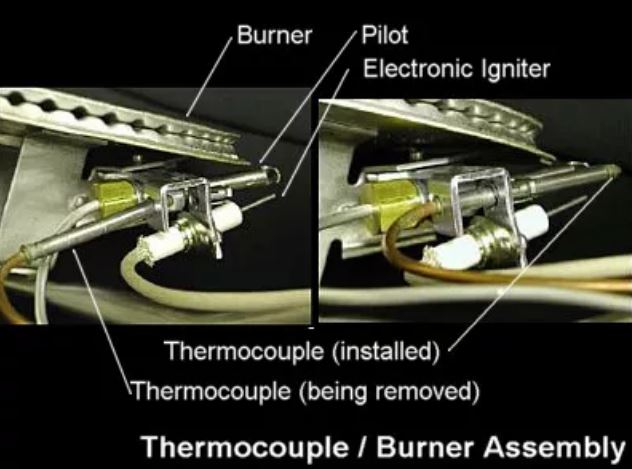How Much Does It Cost To Replace A Thermocouple

A faulty thermocouple can bring your heating system to a screeching halt. While it might seem like a minor component, this small safety device is crucial for ensuring your furnace or gas fireplace operates safely and efficiently. Understanding the cost to replace a thermocouple, along with associated factors, is key to keeping your energy bills low and your home comfortable. This article breaks down the costs, factors affecting pricing, and even explores how upgrading to a smart thermostat can prevent future issues and maximize energy savings.
What is a Thermocouple and Why Does It Matter?
Before diving into the costs, let's quickly define what a thermocouple is and its importance. Essentially, it's a safety sensor that detects the presence of a pilot light or burner flame in gas-powered appliances. If the flame goes out, the thermocouple shuts off the gas supply, preventing dangerous gas leaks. Without a functioning thermocouple, your furnace, water heater, or gas fireplace will simply not operate.
Ignoring a faulty thermocouple can be risky. Not only will you be without heat, but a compromised gas system poses a significant safety hazard. Regular maintenance and prompt repairs are crucial for safe and efficient operation.
The Cost Breakdown: Replacing a Thermocouple
The cost to replace a thermocouple typically ranges from $75 to $250, including parts and labor. However, several factors can influence this price:
- Type of Appliance: Replacing a thermocouple in a simple gas fireplace might be less expensive than replacing one in a complex furnace system. Furnaces often require more intricate disassembly and reassembly.
- Accessibility: If the thermocouple is difficult to access, the labor costs will increase. This is especially true in older systems or those with limited space.
- Technician's Hourly Rate: HVAC technicians' rates vary depending on location and experience. Expect to pay between $75 and $150 per hour for labor.
- Parts Cost: The thermocouple itself is a relatively inexpensive part, typically costing between $10 and $50. However, premium or specialized thermocouples can be more expensive.
- Emergency Service: If you require service outside of normal business hours, you'll likely incur higher emergency service fees.
To illustrate this, consider a few scenarios:
- Simple Gas Fireplace Replacement: Parts ($15) + 1 hour labor ($85) = $100 (approximate cost)
- Standard Furnace Replacement: Parts ($30) + 1.5 hours labor ($127.50) = $157.50 (approximate cost)
- Complex Furnace Replacement (Difficult Access): Parts ($45) + 2 hours labor ($200) = $245 (approximate cost)
DIY vs. Professional Thermocouple Replacement
While replacing a thermocouple might seem like a simple DIY project, it's generally recommended to hire a qualified HVAC technician. Working with gas lines can be dangerous, and improper installation can lead to gas leaks or other hazards. A professional technician will have the necessary tools, experience, and expertise to ensure the job is done safely and correctly.
However, if you're comfortable working with gas appliances and have experience with similar repairs, you can attempt a DIY replacement. Always turn off the gas supply before starting any work. Watch instructional videos, consult your appliance's manual, and take all necessary safety precautions.
Warning: If you smell gas at any point during the process, evacuate the area immediately and call your local gas company or 911.
Beyond the Thermocouple: Optimizing Your HVAC System for Energy Efficiency
Replacing a thermocouple is often just the first step in ensuring your HVAC system operates efficiently. Here are some additional measures you can take to lower your energy bills:
Regular HVAC Maintenance
Schedule annual maintenance for your furnace, air conditioner, and other HVAC equipment. Regular tune-ups can identify potential problems before they become major issues, improve efficiency, and extend the lifespan of your system. Technicians will typically clean components, check for leaks, and ensure proper operation.
Upgrade to a Smart Thermostat
A smart thermostat can significantly reduce your energy consumption by automatically adjusting the temperature based on your schedule, occupancy, and even weather conditions. Energy Star certified smart thermostats can save you up to 8% on your heating and cooling bills. Many smart thermostats also offer features like remote control via a smartphone app, energy usage tracking, and integration with other smart home devices.
Consider the Nest Learning Thermostat or the Ecobee SmartThermostat, both highly rated for their ease of use and energy-saving capabilities. These thermostats "learn" your heating and cooling preferences and automatically adjust the temperature to optimize energy efficiency.
Improve Insulation
Proper insulation is crucial for keeping your home comfortable and reducing energy waste. Ensure your attic, walls, and floors are adequately insulated. Look for air leaks around windows, doors, and other openings, and seal them with caulk or weather stripping. According to the U.S. Department of Energy, proper insulation can save you up to 15% on your heating and cooling bills.
Seal Ductwork
Leaky ductwork can waste a significant amount of energy, especially in older homes. Seal any leaks with duct tape or mastic sealant. Consider hiring a professional to conduct a ductwork inspection and sealing for optimal results.
Consider a System Upgrade
If your furnace or air conditioner is more than 15 years old, it might be time to consider upgrading to a more energy-efficient model. Newer systems often have higher AFUE (Annual Fuel Utilization Efficiency) ratings for furnaces and SEER (Seasonal Energy Efficiency Ratio) ratings for air conditioners, indicating greater energy efficiency. While the initial investment can be substantial, the long-term energy savings can be significant.
Rebates and Incentives for Energy-Efficient Upgrades
Many utility companies and government agencies offer rebates and incentives for homeowners who invest in energy-efficient upgrades. Check with your local utility company and visit the Energy Star website to learn about available programs in your area. These rebates can help offset the cost of upgrades like smart thermostats, insulation, and high-efficiency HVAC systems.
The Inflation Reduction Act also provides tax credits for energy-efficient home improvements, including HVAC upgrades. These credits can significantly reduce the overall cost of making your home more energy-efficient.
Smart HVAC Integration: The Future of Energy Savings
Integrating your HVAC system with a smart home ecosystem can further enhance energy efficiency and convenience. Smart home hubs like Amazon Alexa and Google Home allow you to control your thermostat, monitor energy usage, and even automate temperature adjustments based on your location or other factors. You can also integrate smart sensors to detect occupancy and automatically adjust the temperature accordingly.
For example, you could set up a routine that automatically lowers the thermostat temperature when you leave for work and raises it again shortly before you arrive home. This level of automation can significantly reduce energy waste and lower your utility bills.
Troubleshooting Common Thermocouple Issues
Before calling a technician, here are a few simple troubleshooting steps you can try:
- Check the Pilot Light: Ensure the pilot light is lit and burning steadily. If it's flickering or going out, try cleaning the area around the pilot light with a small brush.
- Clean the Thermocouple: Sometimes, a buildup of soot or debris on the thermocouple can prevent it from working properly. Gently clean the thermocouple with fine-grit sandpaper or steel wool.
- Inspect the Connections: Make sure the thermocouple is securely connected to the gas valve. Loose connections can cause intermittent problems.
If these steps don't resolve the issue, it's best to call a qualified HVAC technician for professional diagnosis and repair.
Conclusion: Investing in Safety and Efficiency
Replacing a thermocouple is a relatively minor expense compared to the potential risks of a malfunctioning gas appliance. By understanding the costs involved and taking proactive steps to maintain your HVAC system, you can ensure your home is safe, comfortable, and energy-efficient. Investing in smart thermostats, proper insulation, and regular maintenance can further reduce your energy bills and create a more sustainable living environment. Don't hesitate to consult with a qualified HVAC professional to assess your system and recommend the best solutions for your needs.










